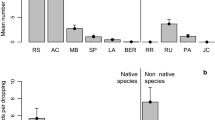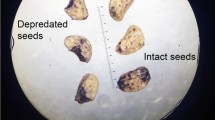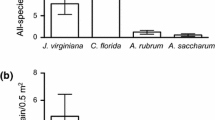Abstract
Across the Pacific, island vegetation is altering in response to changes in seed disperser assemblages brought about by extinctions and introductions of birds and other animals. On the Cook Islands in the South Pacific, the Pacific Banyan (Ficus prolixa, Moraceae) is undergoing little if any recruitment, possibly linked to a lack of dispersal agents. On Rarotonga, where F. prolixa is found in semi-urban and agricultural environments, there is no recent recruitment in contrast to the situation on Atiu where the tree is common in native forest. We examined the quality and quantity of seed dispersal offered to F. prolixa by the available frugivores on these islands, comparing the effectiveness of extant native and introduced species. The native Cook Islands fauna, particularly birds and bats, appear to be the most effective seed dispersers of F. prolixa, both in terms of quantity and quality. Whilst these are relatively numerous on Atiu, they rarely visit F. prolixa on Rarotonga. The native Chocolate hermit crab Coenobita cavipes is a previously unreported additional native seed disperser, conferring low quantity, but high quality dispersal. Introduced birds and mammals are the most numerous F. prolixa frugivores on Rarotonga and in non-forest environments on Atiu, but they act mainly as seed predators. Consequently, the losses and rarity of remaining native frugivores have not been compensated for by introduced species on Rarotonga which may be contributing to the absence of recruitment there.

Similar content being viewed by others
References
Allen MS, Wallace R (2007) New evidence from the East Polynesian gateway: substantive and methodological results from Aitutaki, southern Cook Islands. Radiocarbon 49:1163–1179
Babweteera F, Brown N (2009) Can remnant frugivore species effectively disperse tree seeds in secondary tropical rain forests? Biodivers Conserv 18:1611–1627
Barnes DKA (1997) Ecology of tropical crabs at Quirimba Islands, Mozambique: vertical migration (tree climbing). Mar Ecol Prog Ser 158:233–240
Campbell DJ, Atkinson IAE (1999) Effects of kiore (Rattus exulans Peale) on recruitment of indigenous coastal trees on northern offshore islands of New Zealand. J R Soc N Z 29:265–290
Christian CE (2001) Consequences of a biological invasion reveal the importance of mutualism for plant community. Nature 413:635–638
Compton SG, McCormack GV (1999) The Pacific Banyan in the Cook Islands: have its pollination and seed disperser mutualisms been disrupted, and does it matter? Conserv Biol 8:1701–1715
Cordiero NJ, Howe HF (2001) Low recruitment of trees dispersed by animals in African forest fragments. Conserv Biol 15:1733–1741
Corlett RT (1998) Frugivory and seed dispersal by vertebrates in the Oriental (Indomalayan) region. Biol Rev 73:413–448
Corner EJH (1963) Ficus in the Pacific region. In: Gressitt JL (ed) Pacific basin biogeography. Bishop Museum Press, Hawaii
Cousins JA, Compton SG (2005) The Tongan flying fox Pteropus tonganus: status, public attitudes and conservation in the Cook Islands. Oryx 39:196–203
Cox PA (1983) Extinction of Hawaiian avifauna resulted in a change of pollinators for the ieie. Freycinetia Arborea Oikos 41:195–199
Cox PA, Elmqvist T, Pierson ED et al (1991) Flying foxes as strong interactors in South Pacific island ecosystems: a conservation hypothesis. Conserv Biol 5:448–454
Delgado Garcia JD (2002) Interaction between introduced rats and a frugivore bird-plant system in a relict island forest. J Nat Hist 36:1247–1258
Foster JT, Robinson SK (2007) Introduced birds and the fate of the Hawaiian Rainforest. Conserv Biol 21:1248–1257
Franklin J, Steadman DW (1991) The potential for conservation of Polynesian birds through habitat mapping and species translocation. Conserv Biol 5:506–521
Green PT, O’Dowd J, Lake PS (1997) Control of seedling recruitment by land crabs in rain forest on a remote oceanic island. Ecology 78:2474–2486
Greenaway P, Linton SM (1995) Dietary assimilation and food retention time in the herbivorous terrestrial crab Gecardoidea natalis. Physiol Zool 68:1006–1028
Howe HF, Smallwood J (1982) Ecology of seed dispersal. Annu Rev Ecol Syst 13:201–228
McConkey KR, Drake DR (2006) Flying foxes cease to function as seed dispersers long before they become rare. Ecology 87:271–276
McConkey KR, Meehan HJ, Drake DR (2004) Seed dispersal by Pacific pigeons (Ducula pacifica) in Tonga, Western Polynesia. Emu 104:369–376
Meehan HJ, McConkey KR, Drake DR (2002) Potential disruptions to seed dispersal mutualisms in Tonga, Western Polynesia. J Biogeogr 29:695–712
Midya S, Brahmachry RL (1991) The effect of birds upon the germination of banyan (Ficus bengalensis) seeds. J Trop Ecol 7:537–538
Nogales M, Delgado JD, Medina FM (1998) Shrikes, lizards and Lycium intricatum (Solanaceae) fruits: a case of indirect seed dispersal on an oceanic island (Alegranza, Canary Islands). J Ecol 86:866–871
Olesen JM, Valido A (2003) Lizards as pollinators and dispersers: an island phenomena. Trends Ecol Evol 18:177–181
Pimm SL, Moulton MP, Justice LJ (1995) Bird extinctions in the central Pacific. In: Lawton JH, May RM (eds) Extinction rates. Oxford University Press, Oxford
Price MV, Jenkins SH (1986) Rodents as seed consumers and dispersers. In: Murray DR (ed) Seed dispersal. Academic Press, Sydney
Proctor VW (1968) Long distance dispersal of seeds by retention in digestive tract of birds. Science 160:321
Riera N, Traveset A, Garcia O (2002) Breakage of mutualisms by exotic species: the case of Cneorum tricoccon L. in the Balearic Islands (Western Mediterranean Sea). J Biogeogr 29:713–719
Robertson HA, Hay RD, Saul EK et al (1994) Recovery of the Kakerori: an endangered forest bird of the Cook Islands. Conserv Biol 8:1078–1086
Schupp EW (1993) Quantity, quality and effectiveness of seed dispersal by animals. Vegetatio 107(108):15–29
Serio-Silva JC, Rico-Gray V (2002) Interacting effects of forest fragmentation and howler monkey foraging on germination and dispersal of fig seeds. Oryx 36:266–271
Shanahan M, Samson SO, Compton SG et al (2001) Fig-eating by vertebrate frugivores: a global review. Biol Rev 76:529–572
Shilton LA, Altringham JD, Compton SG et al (1999) Old World bats can be long-distance seed dispersers through extended retention of viable seeds in the gut. Proc R Soc Lond, Ser B: Biol Sci 266:219–223
Smith P (1898) J Polyn Soc 1898:177
Steadman DW (1995) Prehistoric extinctions of Pacific island birds: biodiversity meets zooarchaeology. Science 267:1123–1131
Steadman DW (1997) The historic biogeography and community ecology of Polynesian pigeons and doves. J Biogeogr 24:737–753
Steadman DW (2006) Extinction and biogeography of tropical Pacific birds. The University of Chicago Press, Chicago
Valido A, Nogales M (1994) Frugivory and seed dispersal by the lizard Gallotia galloti (Lacertidae) in a xeric habitat on the Canary islands. Oikos 70:403–411
Vougioukalou SA (2000) Consequences of forest fragmentation on the fruiting patterns of the Pacific Banyan, Ficus prolixa and its associated hymenopteran fauna, in the Cook Islands, South Pacific. Dissertation, The University of Leeds, UK
Whiting MJ, Greef JM (1997) Facultative frugivory in the Cape flat lizard, Platysarus capensis (Sauria: Cordylidae). Copeia 4:811–818
Acknowledgments
For their help during fieldwork we thank Sonia Vougioukalou, Gerald McCormack (Cook Islands Biodiversity and Natural Heritage), Ed Saul (Cook Islands Conservation Service), George Mateariki and the late Maddie, to whom this paper is dedicated. Thanks also to Richard Thewlis, Rachel Wiltshire and Paul Dalton. For research permits we thank the Cook Islands Government. S.C.S. and A.P. gratefully acknowledge financial support from the Mouat Jones/Harvey/Boyle Travel Fund and the Garstang Priestly Travel Fund. We thank two anonymous reviewers for their helpful comments and suggestions for this paper.
Author information
Authors and Affiliations
Corresponding author
Rights and permissions
About this article
Cite this article
Staddon, S.C., Compton, S.G. & Portch, A. Dispersal of fig seeds in the Cook Islands: introduced frugivores are no substitutes for natives. Biodivers Conserv 19, 1905–1916 (2010). https://doi.org/10.1007/s10531-010-9811-3
Received:
Accepted:
Published:
Issue Date:
DOI: https://doi.org/10.1007/s10531-010-9811-3




